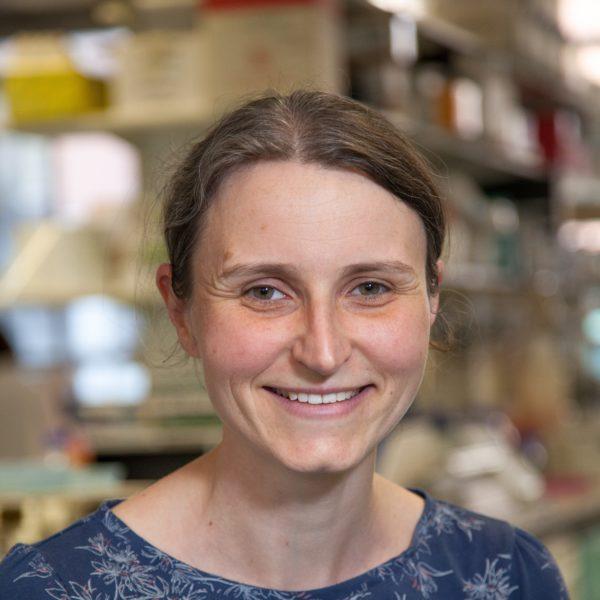Research Focus
My lab focuses on discovering functions of phosphorylation induced by damaged DNA in normal and cancer cells, and investigating the role of different phosphorylation events in cancer development.
Key Publications
MRE11 stability is regulated by CK2-dependent interaction with R2TP complex. Oncogene (2017) 36(34):4943-4950. PMID: 28436950
CK2-dependent PIH1D1 interactions define substrate specificity of the R2TP co-chaperone complex. Cell Rep (2014) 7: 19-26. PMID: 24656813
CK2 phospho-dependent binding of R2TP complex to TEL2 is essential for mTOR and SMG1 stability. Mol Cell (2010) 39: 839-50. PMID: 20864032
DNA damage response as a candidate anti-cancer barrier in early human tumorigenesis. Nature (2005) 434: 864-70. PMID: 15829956
Major Funding
- 2016-2021- Wellcome Trust, Sir Henry Dale Fellowship, Identification of novel protein interactions within DNA damage pathways regulated by non-canonical and novel DNA damage kinases, £954,102
Research
My lab aims to identify novel protein interactions dependent on phosphorylation between DNA damage response proteins. We also aim to identify kinases, responsible for phosphorylation, and discover their precise function in the DNA damage response.
We hope that our work will bring deeper understanding of the DNA damage response, its regulation and interplay with other cellular processes. Understanding how DNA damage repair is carried out and regulated is essential for identification and further development of new and more efficient cancer treatments.
DNA is continually exposed to damaging agents such as UV light or products of cellular metabolism. Exposure to these agents can result in damage leading to harmful DNA mutations. Such mutations can deregulate cellular division and development and subsequently trigger transformation of normal cells into cancer cells. Cells therefore have DNA damage repair mechanisms, which are essential for their survival and act as an anti-cancer barrier.
The DNA repair mechanisms are controlled and regulated by phosphorylation signalling, which can activate or deactivate phosphorylated proteins or create or unique binding sites for other proteins. Mutations of kinases that carry out phosphorylation involved in DNA damage response or mutations of their target sites in DNA damage repair proteins are frequently found in tumours. At the same time drugs that inhibit enzymatic activity of the already known kinases regulating DNA damage response are already used as cancer chemotherapeutics.
Major Funding
- 2016-2021- Wellcome Trust, Sir Henry Dale Fellowship, Identification of novel protein interactions within DNA damage pathways regulated by non-canonical and novel DNA damage kinases, £954,102
Recent Publications
Impaired NHEJ repair in amyotrophic lateral sclerosis is associated with TDP-43 mutations Konopka A, Whelan DR, Jamali MS et al. Molecular Neurodegeneration (2020) 15(10) 51
Nuclear localisation of 53BP1 is regulated by phosphorylation of the nuclear localisation signal von Morgen P, Lidak T, Horejsi Z et al. Biology of the Cell (2018) 110(10) 137-146
Assembly of the U5 snRNP component PRPF8 is controlled by the HSP90/R2TP chaperones Malinová A, Cvačková Z, Matějů D et al. Journal of Cell Biology (2017) 216(10) 1579-1596
MRE11 stability is regulated by CK2-dependent interaction with R2TP complex von Morgen P, Burdova K, Flower TG et al. Oncogene (2017) 36(10) 4943-4950
Human RIF1 and protein phosphatase 1 stimulate DNA replication origin licensing but suppress origin activation Hiraga S, Ly T, Garzón J et al. EMBO Reports (2017) 18(10) 403-419
Substrate recognition and function of the R2TP complex in response to cellular stress von Morgen P, Hořejší Z, Macurek L Frontiers in Genetics 6(10) 69
FANCM-FAAP24 and HCLK2: Roles in ATR signalling and the Fanconi Anemia pathway Horejŝí Z, Collis SJ, Boulton SJ Cell Cycle (2009) 8(10) 1133-1137
Phosphorylation-Dependent PIH1D1 Interactions Define Substrate Specificity of the R2TP Cochaperone Complex Hořejší Z, Stach L, Flower TG et al. Cell Reports (2014) 7(10) 19-26
HELQ promotes RAD51 paralogue-dependent repair to avert germ cell loss and tumorigenesis Adelman CA, Lolo RL, Birkbak NJ et al. Nature (2013) 502(10) 381-384
Tripartite Motif-containing 33 (TRIM33) Protein Functions in the Poly(ADP-ribose) Polymerase (PARP)-dependent DNA Damage Response through Interaction with Amplified in Liver Cancer 1 (ALC1) Protein* Kulkarni A, Oza J, Yao M et al. Journal of Biological Chemistry (2013) 288(10) 32357-32369
For additional publications, please click hereBiography
- 2016 I received Sir Henry Dale Fellowship and joined Barts Cancer Institute as a lecturer at the Centre of Molecular Oncology.
- 2014 Senior Scientific Officer in the DNA Damage Response Laboratory, Clare Hall Laboratories, The Francis Crick Institute, London, UK. I continued on discovering new phosphorylation events important for regulation of the DNA Damage Response.
- 2007 Postdoctoral Fellow in the DNA Damage Response Laboratory, Clare Hall Laboratories, London Research Institute, Cancer Research UK, London, UK, led by Dr Boulton. I have been studying the role of Casein Kinase 2 in DNA damage response and discovered a new phospho-bidning domain PIH-N.
- PhD viva in 2006 at Charles University in Prague. The main part of my PhD work was done under supervision of Prof Bartek at the Department of Cell Cycle and Cancer, Institute of Cancer Biology, Danish Cancer Society, Copenhagen, Denmark. I was investigating the role of the DNA damage checkpoint in normal and cancer cell cycle.
- MSc degree in 2001 at Charles University in Prague, Czech Republic. The thesis was carried out at Department of Molecular Virology, Institute of Molecular Genetics, Czech Academy of Sciences, Prague, Czech Republic, under supervision of Dr Dvorak. I was studying the role of transcription factor c-Myb in the development and differentiation of the red blood cells.

